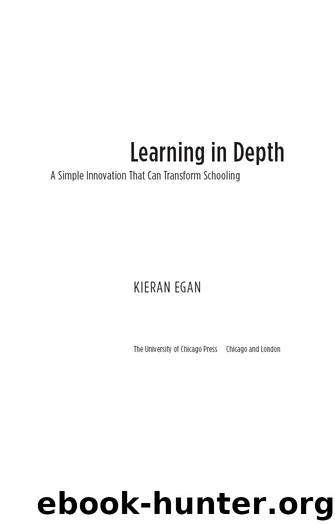Learning in Depth: A Simple Innovation That Can Transform Schooling by Kieran Egan

Author:Kieran Egan
Language: eng
Format: epub
Publisher: University of Chicago Press
Published: 2010-11-17T05:00:00+00:00
5
Some Operating Principles and Examples
A vulnerable part of this proposal is the initial steps. How do we manage to get the five-year-old, or the seven-year-old, sufficiently interested in dust or apples to get the project off the ground? What will they do for the first year or so?—especially if they can’t yet read. Mind you, there are other vulnerable points, such as the major transitions that commonly take place in students’ interests at around age eight—some time after fantasy worlds have evaporated, the Tooth Fairy and Santa Claus are long discarded with the dolls of childhood, and reality-based hobbies and collections begin. The other significant transition is at about age fifteen, when the hobbies and collections tend to be left behind in their turn and are replaced by a greater sense of independence and intense social life.
Building a portfolio over twelve years is going to involve a fair amount of hard work. What I want to do in this chapter is show how we can draw on sources of interest and energy in students to engage them with this work and enable them to see it as worthwhile.
I’ll suggest some teaching principles we can use, derived in part from another project I have been engaged in. This one has involved a Vygotskian-oriented exploration of some of the socioculturally derived cognitive/psychological tools that students have available to make their learning most effective at particular phases of their educational development. Well, that’s one way of putting it. Another would be to say that it has focused attention on what students find spontaneously engaging at different ages and then try to infer from their engagement more general principles that can be applied when teaching. Perhaps it will become clearer as I give some examples. In giving illustrations of the examples I’ll continue to imagine a portfolio based on apples.
My purpose here is not to give descriptions of the kind of teaching approaches that can be found in many good books and Web sites. Rather I want to focus on approaches that may seem a little unusual at first but are well suited to this project and will be particularly helpful in engaging students’ interest in their LiD topics.
Learning Tools for the First Years
The teacher who is supervising portfolios can draw on some of the following learning tools to engage students as they launch into their topic. These tools include the story form; binary opposites and mediations; forming images from words; metaphor use; puzzles and mystery; rhyme, rhythm, and pattern; and humor.
Take the story form. I don’t mean fictional stories, though they are hardly to be excluded. Rather I mean “story” in the sense that we use the term about the evening news. What’s the story on the bridge collapse, or what’s the story on the election, on the movie star’s latest behavioral extravagance, on the local team’s struggle to win the cup, and so on? That is, we are not asking for fictional accounts of these topics. We want the facts, but we
Download
This site does not store any files on its server. We only index and link to content provided by other sites. Please contact the content providers to delete copyright contents if any and email us, we'll remove relevant links or contents immediately.
The Art of Coaching Workbook by Elena Aguilar(51000)
Trainspotting by Irvine Welsh(21521)
Twilight of the Idols With the Antichrist and Ecce Homo by Friedrich Nietzsche(18508)
Fangirl by Rainbow Rowell(9104)
Periodization Training for Sports by Tudor Bompa(8173)
Change Your Questions, Change Your Life by Marilee Adams(7638)
This Is How You Lose Her by Junot Diaz(6800)
Asking the Right Questions: A Guide to Critical Thinking by M. Neil Browne & Stuart M. Keeley(5651)
Grit by Angela Duckworth(5525)
Red Sparrow by Jason Matthews(5392)
Paper Towns by Green John(5092)
Room 212 by Kate Stewart(5041)
Ken Follett - World without end by Ken Follett(4647)
Housekeeping by Marilynne Robinson(4349)
The Sports Rules Book by Human Kinetics(4299)
Double Down (Diary of a Wimpy Kid Book 11) by Jeff Kinney(4208)
Papillon (English) by Henri Charrière(4199)
The Motorcycle Diaries by Ernesto Che Guevara(4018)
Exercise Technique Manual for Resistance Training by National Strength & Conditioning Association(3959)
